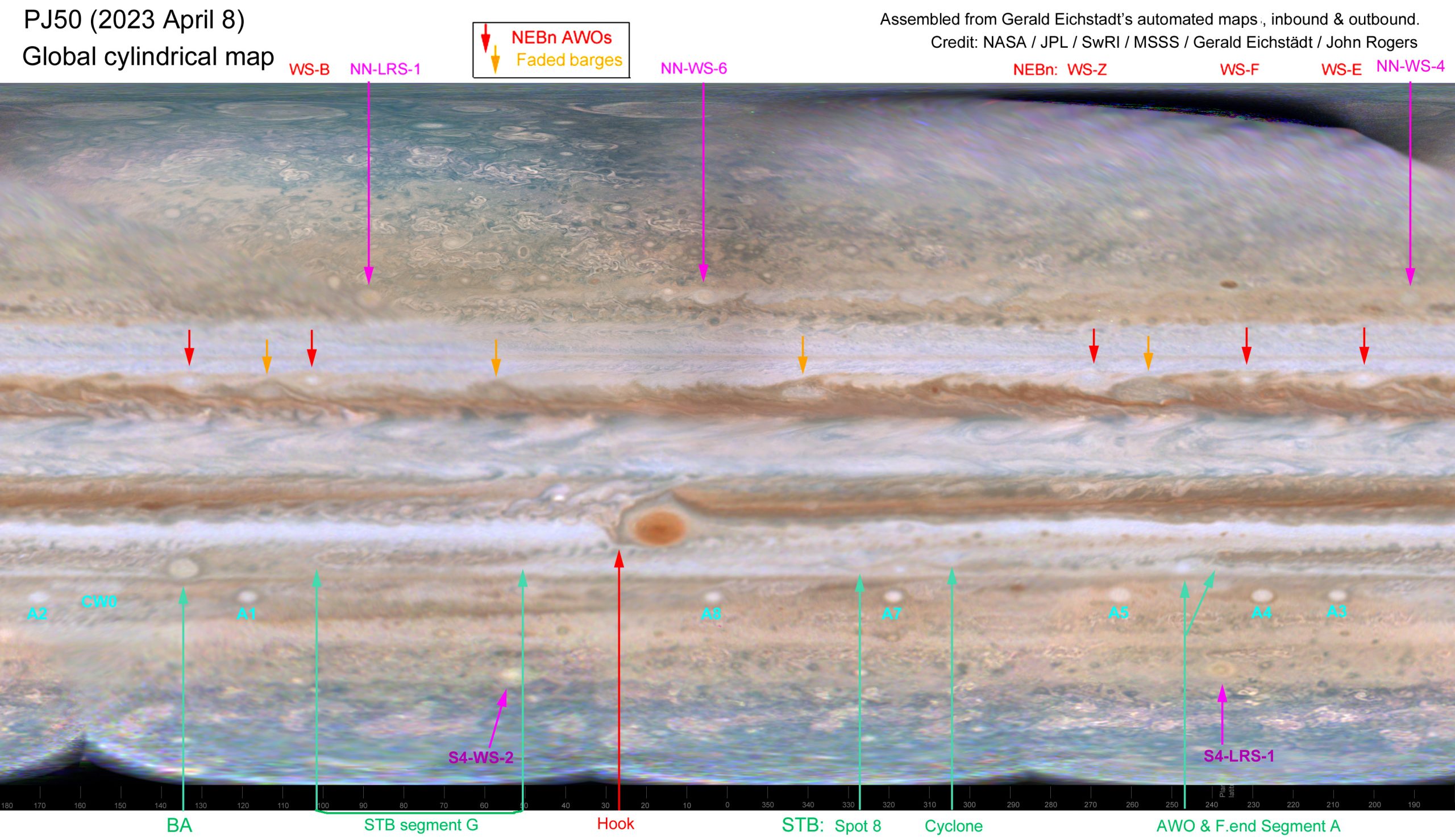Juno at PJ50
JunoCam at PJ50: What the pictures show
–John Rogers (BAA) (2023 May 11)
Juno’s Perijove-50 (PJ50) occurred on 2023 April 8, just 3 days before Jupiter was at solar conjunction from our Earth-based point of view. Therefore, its images give the only view of the planet in this month.
In contrast to the previous 3 perijoves, when some images were lost due to the camera over-heating and due to radiation hits, the planned images at PJ50 were successfully taken and transmitted. After closest approach, fewer images were taken than usual, in order to minimise the risk of problems recurring when they could not be transmitted for a week. However, the most important ones – inbound images covering the last complete rotation of the planet up to north pole crossing, then closeup images of the terminator as Juno moved onto the dark side – were all obtained.
The inbound images (e.g. Figure 1) now cover almost the whole planet, so they provide a complete global map at solar conjunction (Figure 2). There is also a lo-res methane-band map (Figure 3). One notable discovery is a new dark ‘hook’ around the following side of the GRS, which is likely to extend into a dark S. Tropical Band preceding the GRS by the time we next see it. The NEB is fairly normal, as it had been in the past few months, apart from the faded barges; but these seem to be slightly darker grey than they were, perhaps another sign of recovery. The now-familiar features of the STB are recognised, including Segment G which is now about 60° long, and Spot 8 which is confirmed to be a light, slightly pinkish spot with blue-grey flanks (and very methane-dark). The three long-lived anticyclonic ovals in the NNTZ are recognised again, and all are methane-bright
The view of the north polar cyclones is now brief and so covers only just over half of the octagon, but at very high resolution (Figure 4). There are no major changes since PJ49 except that the AWO inside the octagon has moved by an exceptional amount, almost 90° to the west.
The closeup images are the first since PJ47, and confirm that perijove has now moved round to the night side. The images show features very close to the terminator. Image 61 (Figure 5) appears to show definite shadows of some of the bright cloud strips around a N5-AWO, and of one of the linear haze bands over the Bland Zone, which thus appears as a ‘rainbow band’. There are tiny pop-up clouds on the AWO, and in the N4 domain (image 62), but they cast little or no shadows, probably because of overlying haze. Image 63 (Figure 6, left) shows eddies in the NNTB, but only dimly thru diffuse haze; above ~36°N it shows prominent haze bands (esp. a bright ‘rainbow band’ at 40-41°N), but to the south there is only diffuse haze. The subsequent images 64 (taken over the NTB), 65 (over the NEB/EZ), and 66 (over the SEB), show only darkness below, and only the diffuse hazy terminator to north and south. But image 64 does show, on the northern horizon, the most distinct detached haze layer that we have ever seen (Figure 6, right). The horizon is at ~40-41°N, so this layer probably represents the prominent rainbow band shown in image 63. This is in the northern part of the N3 domain, within the range of latitudes where we have seen horizon haze layers at several previous perijoves.
For the record, perijove was at 42°N and equator crossing was at L3 = 283. Juno must have flown very close to White Spot Z, but it was in darkness.
Only a few images were taken outbound, but sufficient to give a lo-res map of the S. Polar Region (Figure 7).
The PJ50 coverage sets the pattern for a new phase in JunoCam’s mission. From now on, the most substantial part of the image coverage will be the last 10 hours before north pole crossing, producing a global map, with high resolution in parts of the northern hemisphere. The north pole, maximally illuminated for the next two years, will be covered at ever-increasing resolution as perijove continues to drift northwards. But the perijove pass itself will be over the night side. This may give opportunity to study high-latitude haze bands more closely, and to search for lightning, but there will be no targeted imaging of known features. South polar maps will still be produced, but at low resolution. We should also note the increasing risk of anomalies as the spacecraft is exposed to more radiation — esp. when outbound at high southern latitudes, where it now passes thru the strongest radiation belt, but also as it approaches Io’s orbit inbound.
Therefore, I will not continue soliciting observations specifically for each perijove, unless our ground-based professional collaborators ask for them; and these reports will probably be brief. All this is just as well now that the interval between perijoves is only 38 days. This will hold until the spacecraft flies past Io when inbound for PJ57 on Dec.30 and PJ58 on 2024 Feb.3, after which the period will be only 33 days. The full schedule is posted on our web site under ‘Results from Juno, 2022’.
This report is available as a PDF with mini-figures: PJ50-report_&Minifigs
The full-size figures are in this ZIP file: PJ50-report_Figures
Here is a small copy of the global map:

| The British Astronomical Association supports amateur astronomers around the UK and the rest of the world. Find out more about the BAA or join us. |
